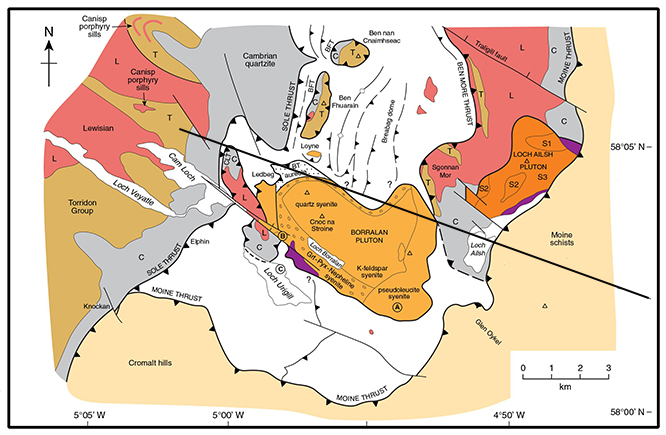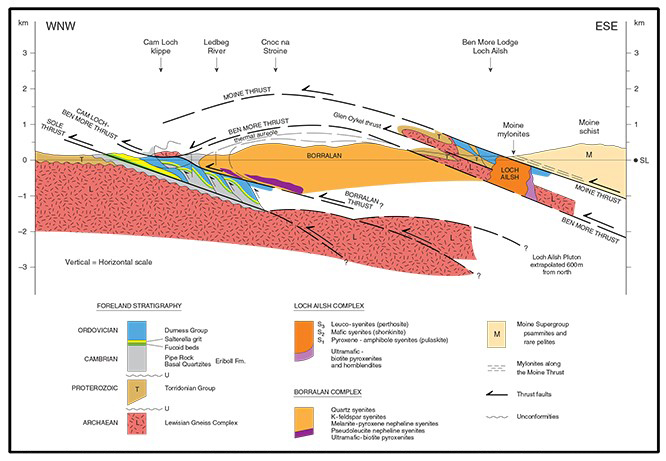Borolanite
The Loch Borralan pluton (fig.1), or Borralan pluton for short, in the SW corner of the Assynt region, was first described by Horne & Teall (1892). Shand (1910, 1913, 1939) carried out detailed petrology and named many rocks of the Borralan complex (e.g. borolanite, ledmorite, cromalite, assyntite).The Borralan intrusion is the only mainly silica-undersaturated plutonic complex in Britain and is composed of a variety of rocks including ultramafic (cromalite with biotite melanite pyroxenites) to mafic nepheline syenites (ledmorites with melanite, augite, nepheline and sodalite) and pseudoleucite - orthoclase bearing borolanites.

Fig.1) Geological map of the Borrolan pluton. CLT, Cam Loch Thrust; BFT, Ben Fhuarain Thrust. A Aultivullin quarry in the Borralan complex; C shows location of the Loch Urigill carbonatite; BT marks the possible Borralan Thrust. Dark line show the cross-section of Borrolan Intrusion. M. P. Searle (2010)
The intrusion covers an area of around 26 km2, and comprises several low hills culminating in Cnoc-na-Sroine at 398 m, surrounded by an area of low, largely peat-covered ground in which most of the more unusual rock types crop out. The higher ground is mainly of leucocratic feldspar-rich syenites, quartz-bearing at the top, while the lower ground comprises undersaturated, usually rather mafic syenites. At the southern margin pyroxenites occur in isolated exposures; geophysical work and drilling have shown that these are part of an extensive sub-vertical sheet between syenite and altered dolomitic limestones. The igneous rocks are in contact along three sides with Cambro-Ordovician Durness Group limestones, while the northern margin is against Cambrian quartzite.
Woolley (1970, 1973) divided the complex into an early suite of pyroxenites, nepheline Syenites and pseudoleucite-bearing syenites, and a later suite of feldspathic syenites (perthosites) and quartz syenites. The later suite of quartz syenites intrudes the earlier nepheline syenite suite, although geochemical data are limited and so it is not possible to establish any definitive relationship between the two suites. The early suite appears to have a sheet-like (laccolithic) form, while the later suite appears to have the form of a plug punching through the earlier rocks. The variety of rocks in the early suite is extremely large, exposure is very poor, and few exposures reveal contact relationships.

Fig.2) Cross-section through the Moine Thrust zone in the Loch Borralan – Cam Loch region of southern Assynt. From M. P. Searle (2010)
The poor exposure of the Loch Borralan intrusion, its exceptional petrological diversity, and its complex tectonic setting, make interpretation of field and petrogenetic relationships extremely difficult.
The current structural view is that the intrusion was emplaced in two major episodes. An early suite, consisting of ultramafic and feldspathoid-bearing rocks involving several pulses of already differentiated magmas. It includes the celebrated pseudoleucite-bearing borolanites.
The later suite is composed of alkali feldspar-syenites (perthosites) and quartz-syenites. It appears to punch through the early suite and may have a stock-like form. It becomes more quartz-rich upwards but sheets of quartz-syenite cut perthosite lower in the mass. These rocks are mineralogically quite similar to, although chemically distinct from, the syenites in the neighbouring Loch Ailsh intrusion.
Ultramafic rocks
Biotite-magnetite pyroxenites, with and without melanite (called cromalite by Shand, 1910), and hornblendites crop out only in the low ground in the SW of the intrusion. The origin of the pyroxenites is controversial. Matthews and Woolley (1977) favoured the Bowen (1928) hypothesis that the pyroxenites are cumulate rocks from the base of the sheet forming the early suite, and postulated that they have been brought to their present attitude by faulting or by squeezing of a partly consolidated layered sequence.Nepheline-syenites
Nepheline-syenites of the early suite crop out extensively in the Ledmore River at Ledmore. These are Shand’s (1910) ledmorites, mesocratic melanite-pyroxene nepheline-syenites.Pseudoleucite-syenite and associated rocks (Borolanite)
This suite, which includes the intrusion’s best known rock type borolanite (Location A), mainly crops out in the eastern part of the complex, and is particularly well exposed around the Allt a’ Mhuillin. The most important exposures are in the quarry east of the Allt a’ Mhuillin, and in the Allt a’ Mhuillin gorge.These are the best exposed localities for borolanite, which is a pyroxene-melanite nepheline-syenite with conspicuous white spots, which are generally believed to be nepheline-alkali feldspar pseudomorphs after leucite. The borolanites are cut by a set of undeformed pegmatite veins containing an assemblage unique in Britain: feldspar, nepheline, biotite, melanite, magnetite, titanite, allanite, zeolites and a blue, sulphatic cancrinite (vishnevite) described by Stewart (1941).
The borolanite contains large white equidimensional leucite crystals that have been pseudomorphed by alkali feldspar, muscovite and nepheline (pseudo-leucite). The pseudoleucite crystals are flattened and elongated into white elliptical streaks aligned in the Moine Thrust transport direction. The breakdown reaction of sodium-rich leucite to nepheline + feldspar occurs at subsolidus temperatures (Deer et al. 1966); therefore the flattened pseudoleucites at Borralan must have been the result of a later tectonic deformation, not an original igneous texture. These high temperature fabrics are restricted to the eastern flank of the Borralan intrusion, and are interpreted as shear fabrics superimposed after crystallization and during thrusting. Other silica-undersaturated rocks in the eastern part of the Borralan complex form an extremely diverse suite. They are exposed sporadically in the ground east of Allt a’ Mhuillin; Some of these rocks reach 15 wt% K2O (Woolley, 1973) and are among the most extreme potassic igneous rocks known on Earth.
Carbonatite
carbonatite was discovered as blocks of orange-brown carbonate rock on the beach at Loch Urigill (location C), where they are still visible (Young et al., 1994). This is the only British example of this important rock type. The carbonate-rock blocks contain xenoliths of syenite and biotite pyroxenite with pronounced reaction rims. Subsequently a white sövite (coarse-grained calcite-carbonatite) was found cutting the Durness Group dolomitic limestone a few metres to the north.The carbonatite body is 400 m outside the contacts of the Loch Borralan intrusion but it is very likely to be part of the magmatism that gave rise to the Loch Borralan mass. The association of carbonatite with nepheline-syenites and diopsidic pyroxenites is recognized worldwide. Chemical evidence that the rocks are carbonatites of deep origin, rather than locally mobilized Durness Group carbonates, comes from their distinctive trace element, carbon and oxygen isotope signatures (Young et al., 1994). The overall extent of the carbonatite in this area cannot be established from the topography owing to the poor exposure.
Late suite
The silica-saturated and oversaturated alkali feldspar-syenites of the late suite are relatively well exposed on the southern slopes of Cnoc-na-Sroine. The rocks are less exotic and controversial than those of the earlier suite, and are similar to the perthosites and melanite syenites in the Loch Ailsh intrusion. The top of Cnoc-na-Sroine is formed of quartz-syenites (nordmarkites) which, with around 12 vol.% quartz, are more quartzose than the quartzsyenites at Loch Ailsh and a little richer in potassium relative to sodium (Parsons, 1972).Sample kindly given to me by Kevin Walsh.
.jpg)
Borolanite. from "Rocks of NW Scotland".
.jpg)
Borolanite. Quarry at Aultivullin. from "Rocks of NW Scotland".
.jpg)
Flattened white Pseudoleucite. Quarry at Aultivullin. from "Rocks of NW Scotland".
.jpg)
white Pseudoleucite and dark green fragment about 10 cm across of a pyroxene-rich mafic rock, Aultivullin. from "Rocks of NW Scotland".
Bibliography
• B.N.Young, I.Parson, R.Threadgold (1994): Carbonatatite near the Loch Borrolan intrusion, Assynt. Journal of the Geological Society, London, 151, 945–954.
• M. P. Searle, R. D. Law, J. F. Dewey and M. J. Streule (2010): Relationships between the Loch Ailsh and Borralan alkaline intrusions and thrusting in the Moine Thrust zone, southern Assynt culmination, NW Scotland. Geological Society, London, Special Publications, 335, 383–404.


.jpg)
.jpg)
.jpg)
.jpg)
.jpg)
.jpg)
.jpg)
.jpg)
.jpg)
.jpg)
.jpg)
.jpg)
.jpg)
.jpg)
.jpg)
.jpg)
.jpg)
.jpg)
.jpg)
.jpg)
.jpg)
.jpg)
.jpg)
.jpg)
.jpg)
.jpg)
.jpg)